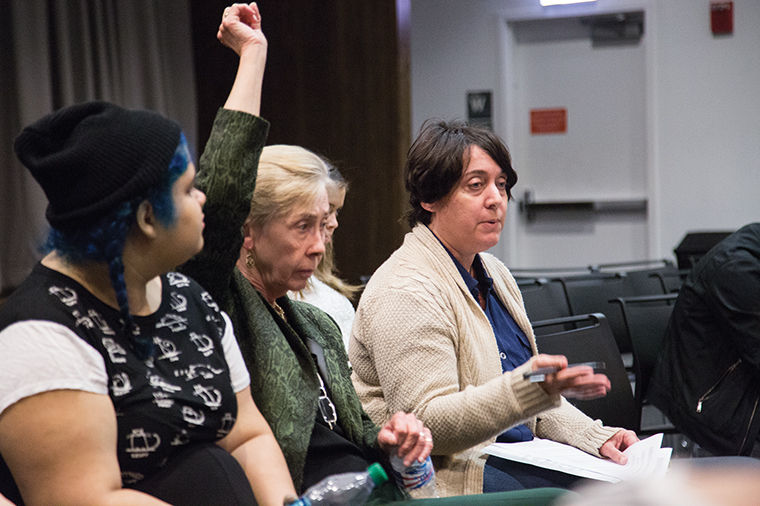SaveColumbia coalition determines petition demands
Diana Vallera and members of the SaveColumbia coalition met April 14 to finalize a list of demands to present to the administration at the final Strategic Planning Steering Committee meeting on April 20.
April 20, 2015
As the college wraps up its strategic planning process, a coalition of students, staff and faculty is embarking on one of its own.
SaveColumbia, an organization that aims to inform the administration of the concerns that campus community members have regarding the Strategic Plan, met April 13 to finalize a list of demands it intends to present to the Strategic Planning Steering Committee at its final meeting on April 20.
According to steering committee member and SaveColumbia activist Diana Vallera, an adjunct professor in the Photography Department and the president of P-Fac, Columbia’s part-time faculty union the demands—which include tuition freezes, budget transparency and smaller class sizes—were also incorporated into a Change.org petition that has obtained 1,280 signatures, as of press time.
“[This resistance] is the consequence of the administration’s actions and its lack of transparency,” Vallera said. “We wouldn’t be here if we had a transparent process and if the top-down decisions weren’t being unilaterally implemented and negatively impacting the students, faculty and staff directly.”
SaveColumbia’s demands include the elimination of all administrative level positions introduced in the Strategic Plan, increased course offerings, the reversal of all course and program eliminations that happened without input from the college community, a shared governance structure including staff, students and full- and part-time faculty, finalizing a contract with the United Staff of Columbia College—Columbia’s staff union—and the following of P-Fac’s collective bargaining agreement, according to Vallera.
If the administration does not meet the petition’s demands by noon on May 1, members of the college plan to organize a sit-in outside of President and CEO Kwang-Wu Kim’s office on the fifth floor in the 600 S. Michigan Ave. Building that day until demands are met, Vallera said.
This will be the final meeting of the SPSC before the Strategic Plan is sent to the board of trustees for approval, Vallera said.
At the forefront of the discussion were concerns regarding tuition increases. Students demanded that the administration introduce a tuition cap by freezing tuition rates based on the year of students’ admittance. As reported Feb. 9 by The Chronicle, tuition will increase by 3.3 percent for the 2015–2016 academic year.
“It’s like raising the price of your dinner while you are eating at the restaurant,” said Susan Tyma, an adjunct professor in the Science & Mathematics Department.
The college’s move to increase class sizes was another concern at the meeting. As reported March 30 by The Chronicle, Senior Vice President and Provost Stan Wearden said he is in favor of increasing the average class size to increase efficiency and save money for the college. Additionally, pilot lecture-hall style courses containing 150–250 students will be tested during the Fall 2015 Semester in the form of a new required first-semester freshman course following the elimination of the First-Year Seminar program in March.
Vallera said increasing class sizes shows a perceived disregard for the adjunct faculty. By increasing class sizes, the college can offer fewer sections of each course, decreasing the number of course assignments available to adjunct professors.
“The heading of Columbia is [leaning] toward less of a college that celebrates the fine and performing arts and more of a college that will be, in five or 10 years, the same as DePaul or Loyola [universities],” said Peter LeGrand, professor Emeritus in the Photography Department. “What we have is an administration that is running scared as hell over a dip in enrollment. This is not going to go away.”
Laura Miller, a junior creative writing major, said she came to Columbia for smaller class sizes and joined the SaveColumbia coalition to ensure the college remains a place for creativity and expression.
“The smaller the class, the better my experience,” Miller said. “In the perfect world, they would be able to go in our shoes and really see what is going on. I am not looking for a miracle, I am just looking for them to give us a chance.”
Wearden said in an April 14 collegewide email that the increase in class size is an efficiency move. The increase in section size will save the college up to $1.6 million annually, which will be invested in the college.
“The administration should see they have such an active community that really cares about students and this college. We can turn this around. There is still time,” Vallera said.








